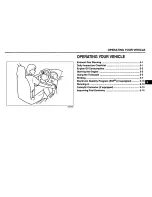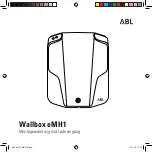
Driving and parking
94
Parking brake
Engaging the parking brake while the
vehicle is in motion can cause the rear
wheels to lock up. You could lose control of
the vehicle and cause an accident. In
addition, the vehicle’s brake lights do not
light up when the parking brake is engaged.
When leaving the vehicle, always remove
the SmartKey from the starter switch, take
it with you, and lock the vehicle. Do not
leave children unattended in the vehicle, or
with access to an unlocked vehicle.
Children could release the parking brake
and/or shift the automatic transmission
out of park position
P, either of which could
result in an accident and/or serious
personal injury.
1
Release handle
2
Parking brake pedal
X
Releasing: Pull on release handle
1
.
When the ignition is switched on or the
engine is running, the brake warning
lamp
;
(USA only) or
3
(Canada
only) in the instrument cluster goes out.
X
Engaging: Step firmly on parking brake
pedal
2
.
When the engine is running, the brake
warning lamp
;
(USA only) or
3
(Canada only) in the instrument cluster
comes on.
Do not turn off the engine before the vehicle
has come to a complete stop. With the
engine not running, there is no power
assistance for the brake and steering
systems. In this case, it is important to keep
in mind that a considerably higher degree
of effort is necessary to brake and steer the
vehicle.
X
Shift the automatic transmission into park
position
P.
X
Engage the parking brake.
i
Always engage the parking brake in
addition to shifting the automatic
transmission into park position
P.
When parked on an incline, also turn the
front wheels towards the road curb.
With SmartKey
X
Turn the SmartKey in the starter switch to
position
0.
X
Remove the SmartKey from the starter
switch.
The immobilizer is activated.
Controls in detail
230_AKB; 1; 42, en-US
d2ureepe,
Version: 2.11.7.1
2008-11-27T15:37:19+01:00 - Seite 94
















































